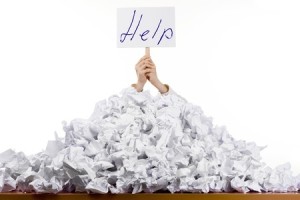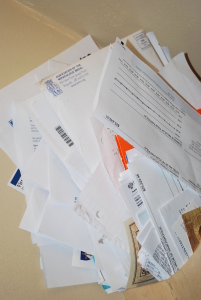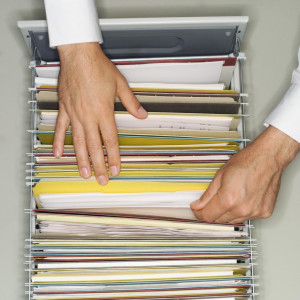Paper. Mail. Magazines. Books.
After time, knowing how to organize paper must be a close second in wishes to the Organizing Fairy Godmother. With tax season upon us, you may be embarking on your own paper organizing journey if for no other reason than you need to get the data to your accountant or your tax software.  Paper is just so tricky, I think, it is easy to accumulate very quickly and takes a long time to sort out and purge. You may even experience anxiety around parting with paper and the information on it, that you may need someday.
Paper is just so tricky, I think, it is easy to accumulate very quickly and takes a long time to sort out and purge. You may even experience anxiety around parting with paper and the information on it, that you may need someday.
Even though we are in an age of digital information, paper seems to be more prevalent than before the time of computers. Did you know? You will receive more mail in one year than your grandparents did in their entire lifetime?
How do you stop the flow and get your paper in order?
Stop the Flow
 Target the Source
Target the Source
You must, if you are to have any hope of getting on top of the paper flow, determine the source of incoming paper. From where is the paper coming into your home or office? Is it:
- mail?
- conferences?
- printouts from work?
- freebies?
Then Stop the Flow
Next, determine a way to stop the flow.
- Ask for digital billing
- Call magazines and catalogs to remove yourself from the list (takes about 2-3 months)
- Use PaperKarma, a free app, to remove yourself from mailing lists
- Be ruthless about what you choose to print from your computer.
- Be careful about what papers you pick up while out of the house.
It’s Not the Paper
Sometimes we receive paper that we do not want. But, it is not the paper itself that is a problem. It is the information. We are addicted to information and worried about losing it or not being able to find that data when think we may need it.
Once you stop the flow of paper into your home and office, the next step is to handle what remains. But, to do so, you must find a way to capture the information that you are confident you will be able to find again.
 Organize Your Paper In Stages
Organize Your Paper In Stages
There are 3 systems that you need in order to handle paper:
- A system to store your paper
- A system to handle new paper arriving
- A system to purge existing paper
Create a system to store your paper.
There are 3 levels of storage. Think of these like the layers of an onion or three concentric circles with you at the center.
- The innermost layer/circle is the paper you need to act on or refer to on a daily basis. It should be at your fingertips. Keep this paper in vertical folders on your desk, a pile filing system, binders or planners.
- The middle layer/circle is the reference level. These items you may refer to weekly or monthly but do not need to be as quickly accessed. Keep these items in a file drawer. This is your traditional filing system.
- The outer layer/circle is furthest from you. This is the storage layer. These items can be kept in boxes at the back of a closet or attic. These are items you must retain for tax or other record keeping purposes but that you do not need to access except for once every year or ten.
Create a system to handle new paper arriving.
If you already reduced the flow, this step will be much easier. Now you are only creating a system around the most important paper that is coming in. You will need to decide where your papers are going to live until you have a chance to handle them. Ideally, when the papers first arrive you will do a quick sort to pull out any recyclable items that you truly don’t need to spend any more energy handling. Then, the remainder should go in an Inbox. An inbox is not a storage location indefinitely. Items here are waiting to be processed. Your inbox should be emptied weekly or better yet, daily.
When you sit down to handle the paper in the inbox the goal should be to capture the information you need and let go of the paper itself. You may need to move items in a bills to pay folder or tax documents to file. But, as much as possible use digital tools or planners to capture important information. Use a calendar to add appointments, events and tasks to complete. Use an app such as Evernote to gather recipes, notes, photos, receipts and more. You may use a smartphone to take a photo of documents and save them into Evernote for future reference. The app will allow you to search your items including the text in images.
Create a system to purge existing paper.
At this point, you may be thinking, “Those two systems would be great but I already have so much paper that I don’t even know where to start!” I understand this dilemma. It is a difficult place to be. This is my recommendation.
- Clear the decks. Use boxes or bags if you have to. Collect all the papers that are every where, box them up and clear your desk space. You need to give yourself a space to work and the ability to handle incoming paper.
- Set aside a time to handle the paper backlog every day until it is gone. 15 minutes a day will do wonders, if you do it consistently.
- Use your paper process that you created in the last step to decide what to keep, what information to capture and what to purge.
- Be ruthless. Paper is a very time consuming item to sort and organize. Each piece requires a decision and this process can be draining. Don’t let these papers sap any more of your energy. Make decisions ahead of time about what you will keep and what you will shred then stick to those rules.
- Create a shred pile or file immediately. Do not create a ‘To File’ pile or you will just be shifting paper from one spot to another. Your shred pile should be MUCH bigger than your keep pile!
Unlike when our grandparents were young, the mere fact that information is captured on paper does not make it important. The filters that once were in place no longer exist and so now, it is up to us to filter papers and information as they come in. Setting up a system to reduce the flow of papers, handle what already exists and set up a processing system can take a couple months or longer. Do not be discouraged. Once it is in place, knowing how to organize paper in the future will be much simpler. You may also find our Paper Retention Guide helpful.
Send me a message and let me know how your process is going. Where are you getting stuck? What is working?
*** Let us share the experience of one or our clients, Barbara. Barbara was very hesitant to have a professional organizer come into her home, but eventually was very glad that she did! Read Barbara’s story about paper organizing here. ***














No comments yet.